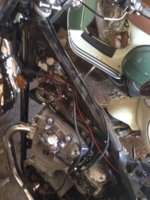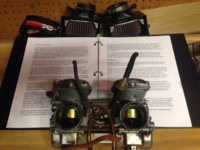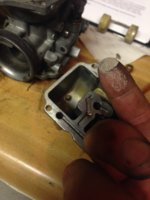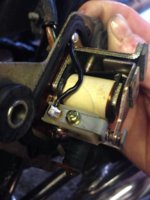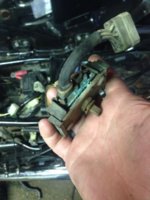DanielBlack
XS650 Junkie
Thank you, Gents.
@5twins: I appreciate the note to check the slide needle. All good, a 4M1, which looks to be correct from my quick research.
@5twins, @MaxPete: You have convinced me. I'll play around with the stock regulator to get the most out of it, but I'll also have my eye out for a deal on a VR-115. But that rat's nest, ugh. Electrical tape-wrapped Radio Shack butt connectors, dead ends (from the Boyer install?), 40yo wire and connectors. I'm a theatrical electrician, and I'm trained to run (and label) cable very neatly for ease in the inevitable last-minute troubleshooting. When I come across cabling this ugly, my instinct is to pull it all to start anew. Often faster than figuring out what's what in a rats' nest. For now, I'll clean and get the stock system up as much as I can, but I've got plans to rewire sometime soonish. No other systems are being addressed until the carbs and rear end are back together. I'm doing well keeping parts organized, but I know my limits. All fasteners begin to look alike.
It looks like there are all sorts of ways all y'all have mounted new reg/rect systems. All comes down to what materials and fabrication skills are available.
MaxPete, your story about the brush Samaritan conflicts greatly with the hundred or so cars which passed me pushing my bike. Not one slowed. A sport bike slowed as he gawked, but I heard his throttle roll on just as he passed. At least common courtesy and hospitality still exist here in this corner of the internet. I consider the passing on of your hard-gained knowledge to be one-in-the-same with passing on those brushes. Thank you.
@5twins: I appreciate the note to check the slide needle. All good, a 4M1, which looks to be correct from my quick research.
@5twins, @MaxPete: You have convinced me. I'll play around with the stock regulator to get the most out of it, but I'll also have my eye out for a deal on a VR-115. But that rat's nest, ugh. Electrical tape-wrapped Radio Shack butt connectors, dead ends (from the Boyer install?), 40yo wire and connectors. I'm a theatrical electrician, and I'm trained to run (and label) cable very neatly for ease in the inevitable last-minute troubleshooting. When I come across cabling this ugly, my instinct is to pull it all to start anew. Often faster than figuring out what's what in a rats' nest. For now, I'll clean and get the stock system up as much as I can, but I've got plans to rewire sometime soonish. No other systems are being addressed until the carbs and rear end are back together. I'm doing well keeping parts organized, but I know my limits. All fasteners begin to look alike.
It looks like there are all sorts of ways all y'all have mounted new reg/rect systems. All comes down to what materials and fabrication skills are available.
MaxPete, your story about the brush Samaritan conflicts greatly with the hundred or so cars which passed me pushing my bike. Not one slowed. A sport bike slowed as he gawked, but I heard his throttle roll on just as he passed. At least common courtesy and hospitality still exist here in this corner of the internet. I consider the passing on of your hard-gained knowledge to be one-in-the-same with passing on those brushes. Thank you.


